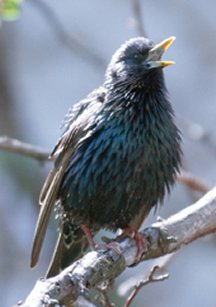At least some birds can learn a pattern once proposed as unique to the grammars of human languages, say researchers.

Starlings trained in a lab have learned to distinguish between sounds strung together like a laundry list and those with nested, or recursive, elements, according to Timothy Q. Gentner of the University of California, San Diego.
Human languages make ample use of recursion. A simple sentence, “Scientists argue about languages,” can expand quickly as the speaker tucks in subordinate bits within the basic framework. For example: “Scientists, who have passionate opinions, argue about languages, of which there are many.”
In 2004, researchers reported that cotton-top tamarins don’t seem to recognize these complex patterns. Now, in the April 27 Nature, another team, which includes Gentner, claims that starlings can pick out that grammar trait. “It’s the first foray into this complex rule learning for a nonhuman animal,” says Gentner.
He traces the origin of the experiment to the 2004 tamarin paper. “We thought, if there’s any species that’s going to be able to do this, it’s starlings,” Gentner says. “They’re just incredible singers.”
He and his colleagues used the same basic pattern of sounds developed for testing tamarins. The laundry list pattern of sounds was represented by a pair of repeated sounds: ABAB, ABABAB, and so on. To pick a very simple case of recursion, the earlier researchers had inserted an extra AB in the center one or more times: AABB, AAABBB, and so on.
To customize the test for starlings, researchers recorded some of the birds’ rattling and warbling calls to use as the A’s and B’s. The researchers then trained 11 adult starlings to peck a key when they heard the more-complex recursive, or AABB type, string of sounds. If the birds heard the ABAB type, they were taught to refrain from pecking.
To find out whether the birds were recognizing recursion instead of using some other rule to distinguish the strings, Gentner’s team tossed in other strings of the sounds.
“It was hard,” says Gentner. Starlings take about 1,000 tries to learn, for example, to distinguish reliably the song of a particular bird. However, consistently sorting out the recursive strings from the nonrecursive ones required some 10,000 to 50,000 tries. Two of the 11 birds never made the grade.
W. Tecumseh Fitch of the University of St. Andrews in Scotland, one of the researchers who tested tamarins, says that he’s glad that the primate work has inspired further investigation. He finds it “quite plausible” that birds do things in communication that nonhuman primates can’t.
However, he cautions that the starlings spent a lot of time in “grammar school,” but the tamarins had received no training. “In some ways, we’re still talking about apples and oranges,” he says.
However, another language specialist, Ray Jackendoff of Tufts University in Medford, Mass., says he’s not persuaded that the birds learned the recursion rule. However, the experiment convinced him that they could handle grammar a bit beyond the basic stringing together of sounds.






